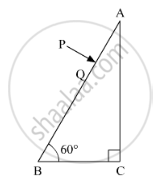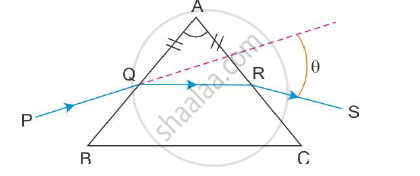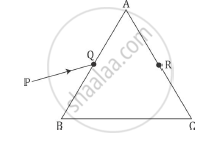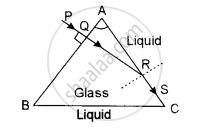Advertisements
Advertisements
Question
The minimum deviations suffered by, yellow and violet beams passing through an equilateral transparent prism are 38.4°, 38.7° and 39.2° respectively. Calculate the dispersive power of the medium.
Solution
Given:-
Minimum deviations suffered by
Red beam, δr = 38.4°
Yellow beam, δy = 38.7°
Violet beam, δv = 39.2°
If A is the angle of prism having refractive index μ, then the angle of minimum deviation is given by
\[\delta = (\mu - 1)A\]
\[\therefore\left( \mu - 1 \right) = \frac{\delta}{A}.........(1)\]
Dispersive power \[\left( \omega \right)\] is given by
\[\omega = \frac{\mu_v - \mu_r}{\mu_y - 1}\]
\[ = \frac{( \mu_v - 1) - ( \mu_r - 1)}{( \mu_y - 1)}\]
From equation (1), we get
\[\omega = \frac{\frac{\delta_v}{A} - \frac{\delta_r}{A}}{\frac{\delta_y}{A}}\]
\[\Rightarrow \omega = \frac{\delta_v - \delta_r}{\delta_y} = \frac{(39 . 2) - (38 . 4)}{(38 . 7)}\]
\[\Rightarrow \omega = \frac{(0 . 8)}{38 . 7} = 0 . 0206\]
So, the dispersive power of the medium is 0.0206.
APPEARS IN
RELATED QUESTIONS
Plot a graph to show the variation of the angle of deviation as a function of the angle of incidence for light passing through a prism. Derive an expression for the refractive index of the prism in terms of angle of minimum deviation and angle of the prism.
A ray PQ incident normally on the refracting face BA is refracted in the prism BAC made of material of refractive index 1.5. Complete the path of ray through the prism. From which face will the ray emerge? Justify your answer.

A ray PQ incident on the refracting face BA is refracted in the prism BAC as shown in the figure and emerges from the other refracting face AC as RS such that AQ = AR. If the angle of prism A = 60° and refractive index of material of prism is `sqrt3 `. Calculate angle θ.

A ray PQ incident on the face AB of a prism ABC, as shown in the figure, emerges from the face AC such that AQ = AR.

Draw the ray diagram showing the passage of the ray through the prism. If the angle of the prism is 60° and refractive index of the material of prism is `sqrt3` , determine the values of angle of incidence and angle of deviation
State any two difference between the primary rainbow and secondary rainbow
The equation \[\omega = \frac{\mu_u - \mu_r}{\mu - 1}\] was derived for a prism having small refracting angle. Is it also valid for a prism of large refracting angle? Is it also valid for a glass slab or a glass sphere?
Can the dispersive power \[\omega = \frac{\mu_u - \mu_r}{\mu - 1}\] be negative? What is the sign of ω if a hollow prism is immersed into water?
The angular dispersion produced by a prism ___________ .
If a glass prism is dipped in water, its dispersive power ___________ .
A prism can produce a minimum deviation δ in a light beam. If three such prisms are combined, the minimum deviation that can be produced in this beam is _______________.
The refractive index of a material M1 changes by 0.014 and that of another material M2 changes by 0.024 as the colour of the light is changed from red to violet. Two thin prisms, one made of M1(A = 5.3°) and the other made of M2(A = 3.7°) are combined with their refracting angles oppositely directed. (a) Find the angular dispersion produced by the combination. (b) The prisms are now combined with their refracting angles similarly directed. Find the angular dispersion produced by the combination.
A narrow beam of monochromatic light, PQ, is incident normally on one face of an equiangular glass prism of refractive index 1.45. When the prism is immersed in a certain liquid, the ray makes a grazing emergence along the other face (See figure). Find the refractive index of this liquid. 
What is meant by the dispersive power of transparent material?
An equilateral glass prism has a refractive index 1.6 in the air. Calculate the angle of minimum deviation of the prism, when kept in a medium of refractive index `4sqrt(2)"/"5.`
Define angular dispersion.
The refractive indices of material for red, violet and yellow colour light are 1.52, 1.62 and 1.59 respectively.
Calculate the dispersive power of the material. If the mean deviation is 40°. What will be the angular dispersion produced by a prism of this material?
Prove that in case of a prism, i + e = A + δ, where the symbols have their usual meanings.
